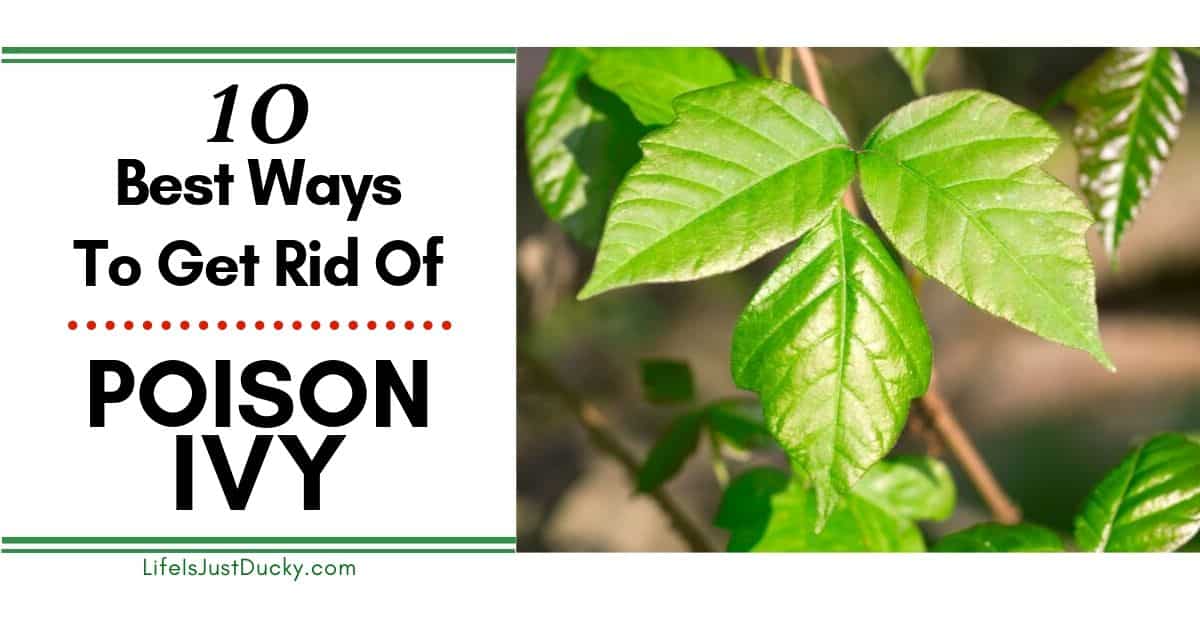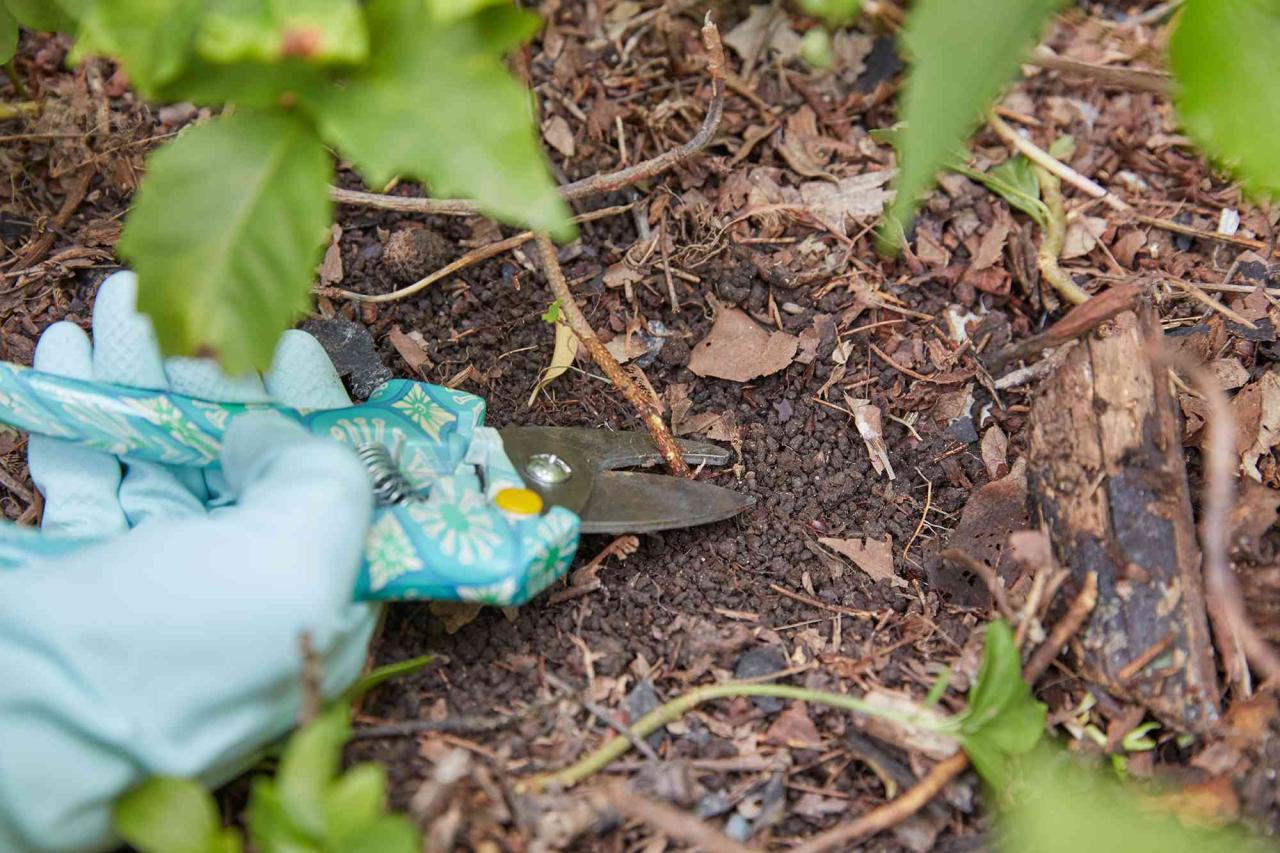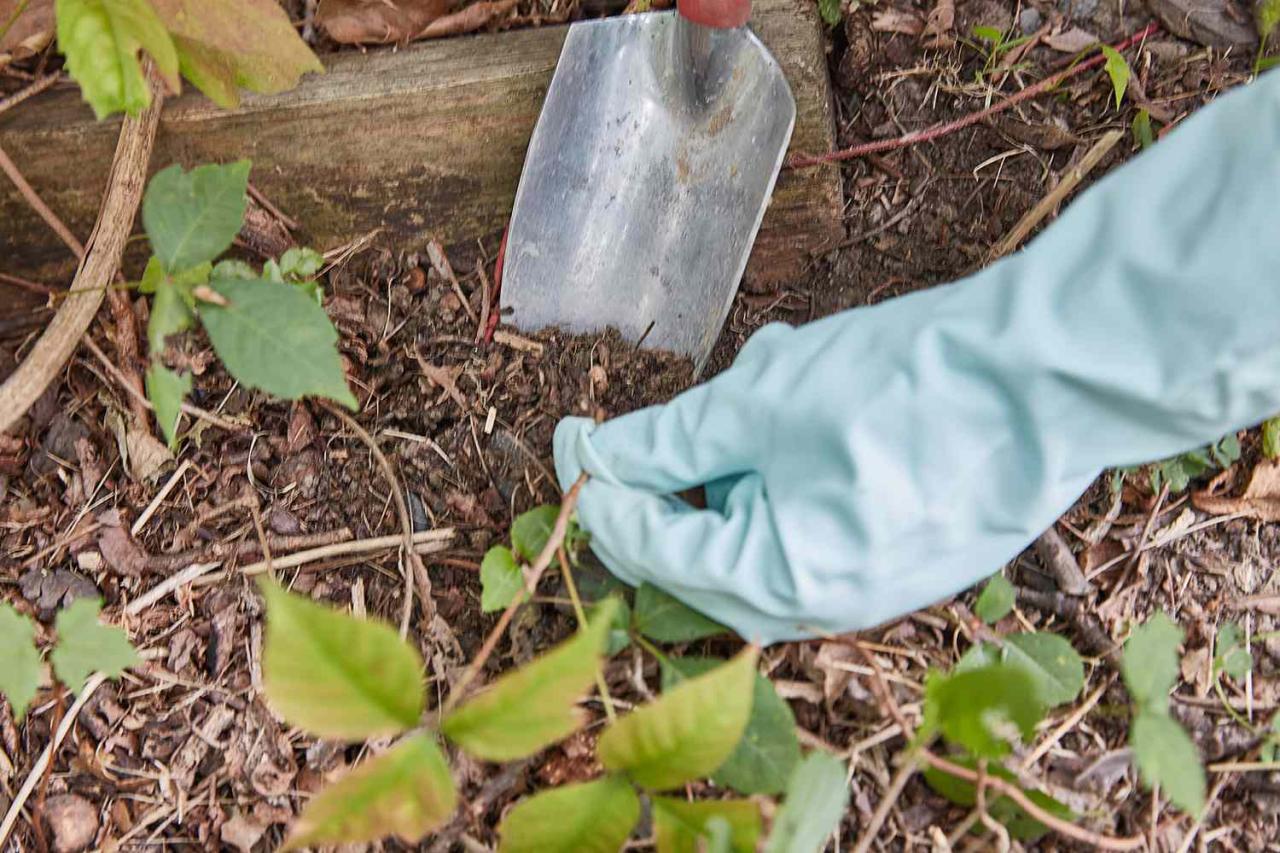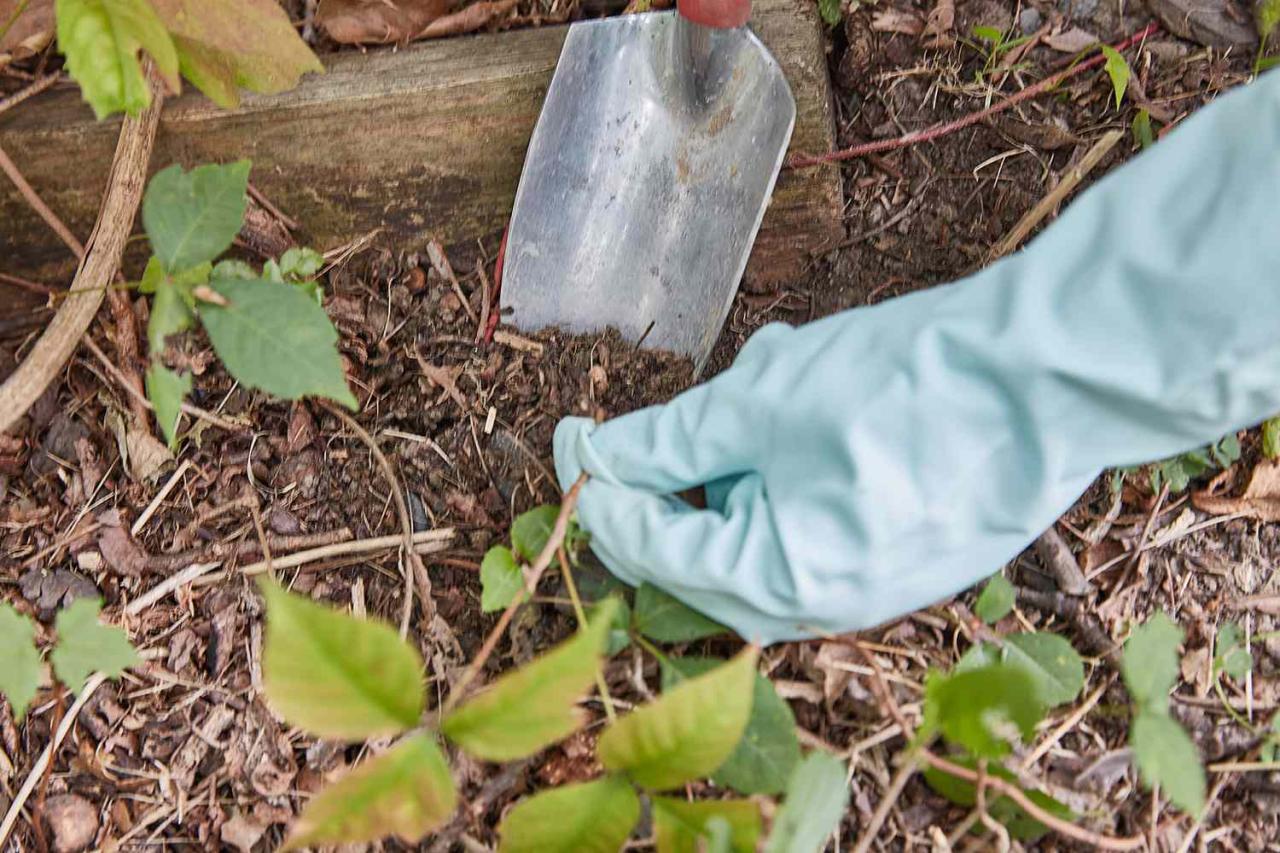Best Techniques for Safely Removing Poison Ivy from Garden Pathways – It’s a task many gardeners face, but the notorious rash-inducing plant can be a real challenge. Poison ivy, with its distinctive three-leaf clusters, thrives in many landscapes, often encroaching on garden pathways and threatening to disrupt your outdoor enjoyment.
The key to safe removal is understanding the plant’s characteristics, using appropriate techniques, and taking proper precautions. This guide will provide you with the knowledge and steps to effectively and safely eliminate poison ivy from your garden pathways.
Understanding the plant’s characteristics is crucial for safe and effective removal. Poison ivy’s three-leaf clusters are its defining feature, and its ability to grow in various forms, including vines and shrubs, makes it adaptable. The plant’s oily resin, urushiol, is the culprit behind the itchy rash.
This resin can remain active on surfaces and even on clothing for years, making it crucial to take protective measures.
Understanding Poison Ivy

Poison ivy is a common plant found throughout North America, and it’s notorious for causing an itchy, painful rash in many people. Understanding its characteristics, growth habits, and the dangers it poses is crucial for safe removal and prevention of allergic reactions.
Appearance and Growth Habits
Poison ivy can grow in various forms, including vines, shrubs, and ground cover. It is easily recognizable by its three leaflets, often with a pointed tip. The leaflets are typically shiny green in the summer and turn vibrant red or orange in the fall.
The plant produces small, white berries in clusters, which are a common way for the plant to spread.
Geographical Distribution, Best Techniques for Safely Removing Poison Ivy from Garden Pathways
Poison ivy is found in all 48 contiguous states in the United States, as well as in parts of Canada and Mexico. It thrives in a wide range of habitats, including forests, fields, roadsides, and even urban areas.
When tackling poison ivy, safety is paramount. Protective gear, including gloves and long sleeves, is essential to prevent skin contact. If you’re planning to add more greenery to your garden, consider hanging plants to maximize space. For a guide on hanging plants without damaging your walls, check out this helpful article: How to Hang Plants Without Damaging Your Walls.
Once the poison ivy is removed, you can add attractive hanging plants to enhance your garden pathways.
Dangers of Poison Ivy and its Effects on Human Health
The primary danger of poison ivy lies in its ability to cause a severe allergic reaction in most people. The plant contains a potent oil called urushiol, which is responsible for the itchy, blistering rash that develops upon contact.
Urushiol Oil and Allergic Reactions
Urushiol is a highly allergenic oil that penetrates the skin upon contact. It binds to skin cells, causing an immune response that results in a characteristic rash. The severity of the reaction can vary depending on individual sensitivity, the amount of exposure, and the length of time the oil remains on the skin.
Safe Removal Techniques
Once you’ve identified poison ivy in your garden pathways, it’s crucial to remove it safely and effectively. Several techniques can be employed, each with its own advantages and disadvantages. This section will explore different methods for removing poison ivy, emphasizing safety precautions and best practices.
Comparing Removal Methods
Choosing the right method for removing poison ivy depends on the extent of the infestation, the accessibility of the plants, and your personal preferences. The following table compares and contrasts different methods:
Method |
Advantages |
Disadvantages |
|---|---|---|
Manual Removal |
Environmentally friendly, cost-effective, provides immediate results. |
Requires careful handling to avoid contact with urushiol, labor-intensive, may not be suitable for large infestations. |
Herbicides |
Effective for large infestations, can kill poison ivy roots, convenient application. |
Potential environmental impact, can harm other plants, may require multiple applications. |
Boiling Water |
Environmentally friendly, effective for small infestations. |
May not reach roots, can damage surrounding plants. |
Vinegar |
Natural, readily available, effective for small infestations. |
May not reach roots, can damage surrounding plants. |
Manual Removal of Poison Ivy
Manual removal involves physically digging up or pulling out poison ivy plants. This method is environmentally friendly and cost-effective, but it requires careful handling to avoid contact with urushiol, the oil that causes allergic reactions. Here’s a step-by-step guide for manually removing poison ivy:
- Gear Up for Safety: Wear protective clothing, including long sleeves, long pants, gloves, and a face mask. It’s also recommended to wear a hat and boots to prevent skin contact with urushiol.
- Prepare the Area: Clear any debris or obstacles around the poison ivy plants. This will make it easier to access and remove the plants.
- Remove the Plants: Use a shovel or garden trowel to dig up the plants, ensuring you remove the entire root system. You can also pull out the plants if they are small and shallowly rooted.
- Dispose of Plants Safely: Do not compost poison ivy plants, as they can still release urushiol. Bag them in sealed plastic bags and discard them in the trash. You can also burn the plants, but this should be done carefully and only in areas where it is permitted.
- Clean Up: After removing the plants, clean your tools and protective gear thoroughly with soap and water. Dispose of the cleaning water in a separate container, not in the garden.
- Monitor the Area: Continue to monitor the area for any regrowth. You may need to repeat the removal process if new plants emerge.
Using Herbicides to Control Poison Ivy
Herbicides can be effective for controlling poison ivy, especially for large infestations or areas where manual removal is difficult. However, herbicides can have environmental impacts and may harm other plants. It’s crucial to select the appropriate herbicide and apply it safely.
- Choose the Right Herbicide: Select a herbicide specifically designed for controlling poison ivy. Some herbicides are systemic, meaning they are absorbed by the plant and kill the entire root system. Others are contact herbicides, which only kill the parts of the plant they come into contact with.
Consult with a local garden center or landscaping professional for recommendations on the best herbicide for your situation.
- Follow Application Instructions: Carefully read and follow the instructions on the herbicide label. This will include information on the correct dosage, application method, and safety precautions.
- Apply Carefully: Avoid spraying herbicides on windy days, as the chemicals can drift and harm other plants. Use a hand-held sprayer or a spot applicator to target the poison ivy plants.
- Monitor for Results: It may take several applications of herbicide to completely eliminate poison ivy. Monitor the area for regrowth and repeat applications as needed.
Protective Measures: Best Techniques For Safely Removing Poison Ivy From Garden Pathways
Protecting yourself from poison ivy is paramount when removing it from your garden pathways. Urushiol, the oil that causes the allergic reaction, can remain potent for years even on dead plants. Therefore, wearing appropriate protective clothing and using barrier creams are essential to prevent contact with the oil.
Protective Clothing and Equipment
The most effective way to prevent urushiol contact is by wearing protective clothing that covers your skin. This includes:
- Gloves:Thick, disposable nitrile gloves provide the best protection. Avoid using cloth gloves, as they can absorb urushiol and transfer it to your skin.
- Long Sleeves and Pants:Wear long-sleeved shirts and long pants to cover your arms and legs. Opt for tightly woven fabrics that urushiol cannot penetrate easily.
- Eye Protection:Safety glasses or goggles are essential to protect your eyes from accidental splashes of urushiol. It’s crucial to wash your eyes immediately with water if you suspect contact.
Barrier Creams
Barrier creams can create a protective layer on your skin, making it more difficult for urushiol to penetrate. These creams are typically made from ingredients like zinc oxide or bentoquatam, which form a physical barrier. While barrier creams can offer some protection, they are not foolproof and should be used in conjunction with protective clothing.
When tackling poison ivy, safety is paramount. Always wear gloves and protective clothing, and remember to wash your hands thoroughly after handling the plant. While you’re focused on keeping your garden pathways clear, consider expanding your green thumb to include air plants – these unique beauties require minimal maintenance and add a touch of whimsy to any space.
For guidance on the best watering techniques for these fascinating plants, check out this informative article on Watering Tips for New Air Plant Owners. Once you’ve mastered the art of air plant care, you can confidently return to your poison ivy removal project, knowing you’re equipped to handle any plant-related challenge with ease.
Barrier creams are not a substitute for protective clothing and should be applied generously and reapplied regularly, especially after sweating or contact with water.
Post-Removal Care

After successfully removing poison ivy from your garden pathways, it’s crucial to take proper post-removal care to prevent further exposure to the plant’s irritating oil, urushiol. This includes safe disposal of the removed plant material, cleaning tools and equipment, and thoroughly washing any skin that may have come into contact with poison ivy.
Proper Disposal of Poison Ivy
Disposing of poison ivy properly is essential to prevent the spread of urushiol and minimize the risk of exposure to others. Here’s a step-by-step guide:
- Double-bagging:Always double-bag the removed poison ivy plants and debris in thick plastic garbage bags. This helps contain any remaining urushiol and prevents it from leaking out.
- Seal tightly:Ensure the bags are securely sealed with multiple twist ties or tape to prevent accidental spills or leaks.
- Discard responsibly:Dispose of the sealed bags in a designated trash container, ideally one intended for hazardous waste. Avoid placing them in compost bins, as they can contaminate the compost and spread urushiol.
- Burn with caution:Burning poison ivy is not recommended as the smoke can carry urushiol particles, potentially causing respiratory irritation and skin reactions. If burning is necessary, it should be done with extreme caution and under strict safety guidelines.
Cleaning Tools and Equipment
Thorough cleaning of tools and equipment used during poison ivy removal is crucial to prevent the spread of urushiol. Here’s how to clean them effectively:
- Wear protective gear:Before cleaning, wear gloves, a long-sleeved shirt, and long pants to protect your skin from contact with urushiol.
- Use soapy water:Wash tools and equipment with soap and water. This helps break down the oily urushiol and remove it from surfaces.
- Bleach solution:For a more thorough cleaning, use a bleach solution (1 part bleach to 10 parts water). Allow the tools to soak in the bleach solution for at least 30 minutes, then rinse them thoroughly with clean water.
- Dispose of cleaning materials:Dispose of any cleaning materials used, such as rags or paper towels, in the same manner as the removed poison ivy plants. Double-bag them and dispose of them in a designated trash container.
Washing Skin After Contact with Poison Ivy
Washing your skin thoroughly after any contact with poison ivy is crucial to minimize the risk of developing a rash. Here are some important steps:
- Wash immediately:Wash the affected area with soap and water as soon as possible after contact. This helps remove any urushiol that may be on your skin.
- Use cold water:Use cold water instead of hot water, as hot water can open pores and potentially increase the absorption of urushiol.
- Scrub gently:Scrub the affected area gently with your hands or a washcloth. Do not use harsh scrubs or abrasive materials, as they can irritate the skin further.
- Rinse thoroughly:Rinse the affected area thoroughly with clean water to ensure all soap and urushiol are removed.
- Repeat washing:Repeat the washing process several times throughout the day, especially if you have been in contact with poison ivy. This helps minimize the amount of urushiol that can penetrate your skin.
Prevention Strategies

Preventing poison ivy from growing in your garden pathways is crucial for avoiding painful encounters with this persistent plant. By implementing a multi-pronged approach that combines proactive measures, regular maintenance, and natural deterrents, you can create a poison ivy-free zone in your garden.
Maintaining Healthy Garden Soil
Healthy soil is less hospitable to poison ivy. Maintaining a balanced pH level and providing adequate drainage can help deter its growth.
- Regular Soil Testing:Conduct soil tests to determine the pH level and nutrient content. Adjust the pH level if necessary using lime or sulfur. Aim for a pH level between 6.0 and 7.0, which is generally optimal for most plants.
- Improving Drainage:Ensure proper drainage to prevent waterlogging. Amend the soil with organic matter, such as compost or peat moss, to improve aeration and drainage. Avoid compacting the soil, which can hinder water penetration.
End of Discussion
Safely removing poison ivy from your garden pathways requires a combination of knowledge, proper techniques, and preventive measures. By understanding the plant’s characteristics, using the right tools and protective gear, and following post-removal care instructions, you can minimize the risk of exposure to urushiol oil.
Remember, prevention is key. Regular maintenance, healthy soil, and the use of natural deterrents can help keep poison ivy at bay, ensuring a safe and enjoyable garden experience.
Essential Questionnaire
Is it safe to burn poison ivy?
No, burning poison ivy is extremely dangerous. The smoke can carry urushiol oil, increasing the risk of inhaling it and developing a severe reaction.
What should I do if I get poison ivy rash?
Wash the affected area with soap and water immediately. Consider using over-the-counter medications like calamine lotion or hydrocortisone cream to relieve itching. If the rash is severe or widespread, consult a doctor.
